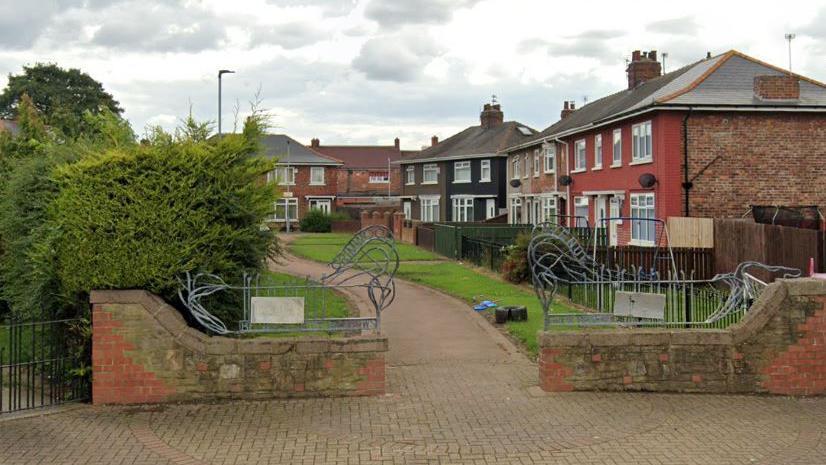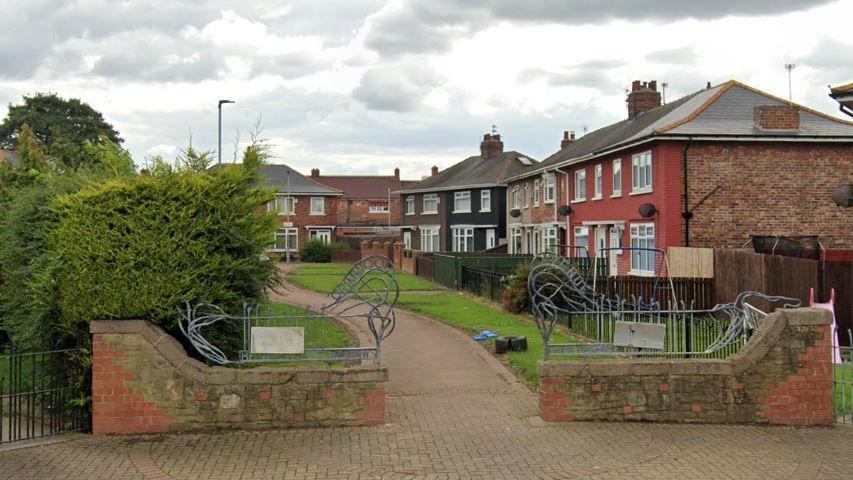Accused may have worn murder scene print trainers

Glenna Siviter was found dead at her home on Grimwood Avenue in Middlesbrough in December
- Published
Shoeprints found at a woman's murder scene may have been a match for trainers allegedly worn by her accused killer, a court has heard.
Glenna Siviter, 50, was stabbed dozens of times and then hidden beneath a sofa at her home in Middlesbrough in December, Newcastle Crown Court heard.
Prosecutors allege her friend Andrew Hall, 46, murdered her to steal her jewellery to sell for drugs which he denies.
A shoe expert said while the trainers Mr Hall was wearing when he was arrested did not leave the prints, the marks could have been made by other trainers prosecutors claim he was wearing on the day Ms Siviter was killed.
Prosecutors allege Ms Siviter was killed at her home on Grimwood Avenue in the early hours of 11 December, with her body found concealed in the living room four days later.
The court has heard drugs users Mr Hall and Ms Siviter were "like brother and sister" and he was a regular visitor to her home.
It is also alleged he stabbed two other men in Middlesbrough in the days between Ms Siviter being killed and her body being discovered, but Mr Hall denies all wrong-doing.
Nike trainers
Forensic footwear specialist Elizabeth Jukes said she examined the UK size 5.5 grey Nike trainers with a "heavily worn" sole Mr Hall was wearing when he was arrested on 15 December, as well as the UK size 5 Nike shoes worn by Ms Siviter's sister Amanda who visited the home on 14 December.
Under questioning from prosecutor Peter Moulson KC, Ms Jukes said both sets of trainers had the so-called Nike 360 sole pattern, as it is listed in the national footwear reference collection, which was "one of the most commonly encountered" soles.
Ms Jukes compared the shoes to six footmarks found in Ms Siviter's living room but she said while there were similarities in the sole patterns, there was "conclusive support" that the shoes "did not make" the marks at the scene.
She said the marks would have been made by another pattern like that found on Nike Air Max 2090 shoes "or something very similar".
Ms Jukes examined CCTV footage of a man prosecutors allege was Mr Hall walking through a bus station on 11 December and said she believed he was wearing Nike Air Max 2090 trainers.
In cross-examination, Mr Hall's barrister Nicholas Lumley KC asked Ms Jukes how many such trainers there were in circulation and while she could not give a figure she said there "would be a lot".
She said she could not say when the marks on the living room floor were made or what size shoe made them.
Ms Jukes also said she was not asked to examine anyone else's footwear, including Ms Siviter's.
The trial continues.
Follow BBC Tees on X (formerly Twitter), external, Facebook, external and Instagram, external. Send your story ideas to northeastandcumbria@bbc.co.uk.
Related topics
More stories from BBC North East and Cumbria
- Published12 June 2024

- Published11 June 2024
